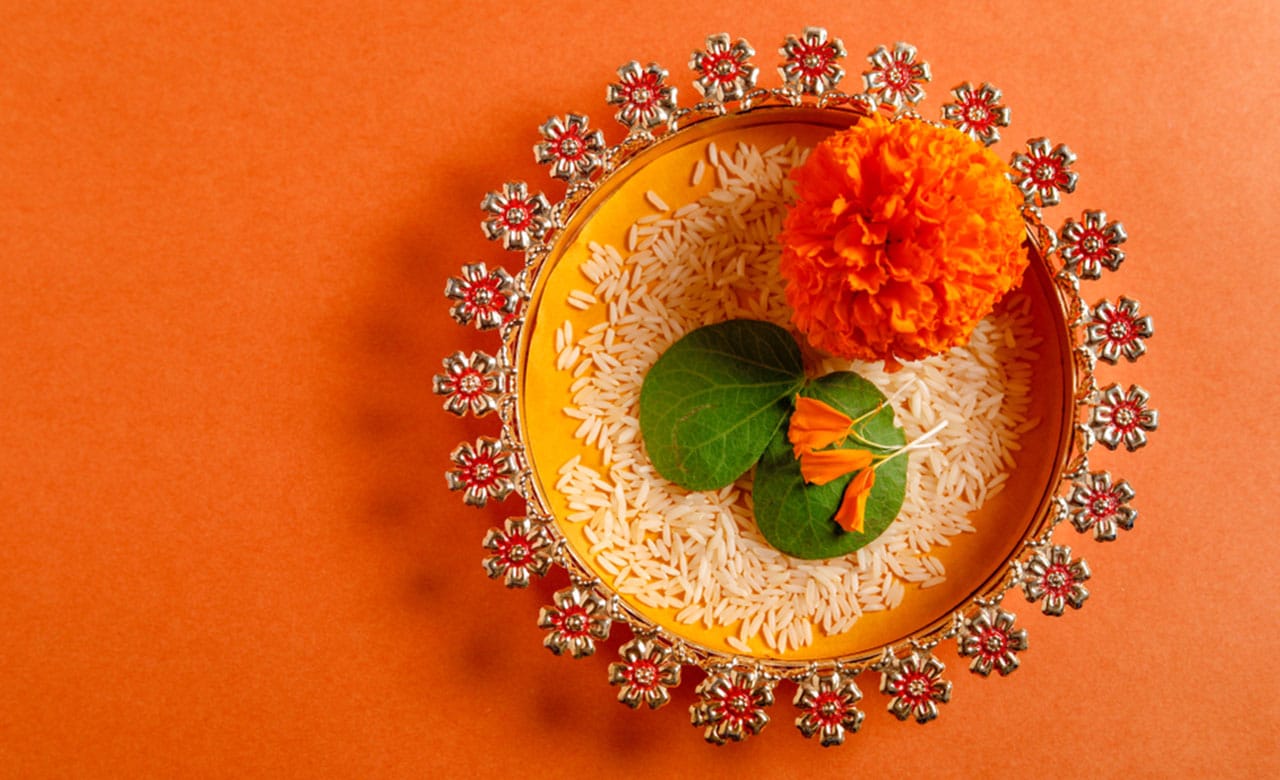
Informative
Akshata: The Holy Rice Grain
Akshata is derived from the word Akshat, which means whole or complete. Akshata are nothing but rice grains used in Hinduism as a part of rituals. No Sanskara or the important Dharmic rituals in Sanatana are complete without Akshata. During Mauji Bandhan or the thread ceremony, the boy is showered with the Akshata. At the exact time during the Muhurta (auspicious time), when bride and groom exchange garlands, they are showered with Akshata.
Whenever a piece of cloth or coconut is presented to the Divine, it’s presented with a pinch of Akshata. While praying to the Yantras, Akshatas are offered to these energy reservoirs. It is believed that Akshata has the power to attract positive vibrations. When kept with us, these little rice grains recharge us with positivity and bestow the energies of the celestial powers.
Types of Akshata
Usually, there are two types of Akshata, white and red. White Akshata represents purity, detachment, and spiritual practice without any expectations. In Sanatana, white Akshatas attract frequencies of deities like Brahma, Vishnu, and Mahesh. They are often presented to Lord Shiva and Satyanarayana, representing fundamental knowledge and action.
Red Akshatas are smeared with Kumkum (vermilion). Whenever we want something in return from the deity, we present them with red Akshatas. May it be a success, a resolution, or good luck, the red Akshata represents the devotion to expectations from the universal powers. Red Akshatas are offered to Lord Ganesha and Divine Mother Durga.
Akshata is used in the following ways
-Oil lamp is kept on the small mound of Akshata. Also, the Kalasha is established on the base created with Akshata.
-Whenever there is a Puja at home, white Akshatas are kept in front of the Homa (fire ceremony) or in front of the deity. Later, it’s added to the regular rice in the kitchen and used for consumption.
-While drawing the holy symbols like Shree, Swastika, Aum, Navagrahas, or Saraswati with Vermillion or Sandal paste during Puja rituals, Akshatas are used with the paste.
-While thinking of Sankalpa, devotees stand in front of the deity holding the Akshata in their hands. They think about their Divine, Tell Them about their Sankalpa, and ask them for the fulfilment of the same.
-Akshata is offered to the deity or Yantras. Later, these are kept with the devotees as they are charged with positivity.
-It is applied on the forehead along with Sandal paste or Vermillion Tilak, which is believed to stimulate the third eye chakra.
Significance of Akshata
In Shiva Mahapuran, an ancient text describing the teachings of Lord Mahadev, Divine Mother Parvati worships the Shiva Lingam, the iconification of Lord Shiva with Akshatas. Vedas, the most ancient texts known to humankind, describe the details and significance of offering Akshatas to the Yagya.
It is said that Akshata attracts the frequencies of the principal deities, like Lord Shiva, Divine Mother Parvati, Lord Surya, Lord Ganesha, and Lord Vishnu. After offering them to God, when the seeker consumes these Akshatas with a meal, it is believed that they acquire the Gunas or the positive attributes of the deity.
When kept under the Kalasha, Akshatas bring out the balance in the frequencies of Apa-Tattva (water principle) and Prutvi-Tattva (earth principle) of the body. Akshata attracts positive energies and improves the mind-body connection. Akshata contains turmeric or vermilion, which has multiple spiritual and health benefits.
Akshata means unbroken. While making Akshata, intact rice is used. Sadhaks believe broken grains in spirituality lose their power to attract positivity from the Divine. Wholesomeness represents the Sattva Guna or the Purity, and broken grain represents Tamas Guna or the dark or illusive characteristics. Offering the unbroken rice to the deity represents the unity of our soul with the Divine one.
Whenever you present the Akshata to the deity, hold the Akshata in the palms of your hand. Close your eyes, and place the Akshata holding your hand on your heart. And chant the following mantra:
अक्षताश्च सुरश्रेष्ठ कुंकुमाक्ता: सुशोभिता:। मया निवेदिता भक्त्या: गृहाण परमेश्वर॥
Akshatashcha Surashreshth Kumkumakta Sushibhita|
Maya Nivedita BhaktyahaGruhan Parameshwara||
Meaning: Oh Lord, this Akshat, adorned with the Vermillion, is dedicated to you; please accept it. Its meaning is that ‘Akshata,’ i.e., rice, is considered to be the best in food. It is also called Deva-Anna because it is considered to be the favourite food of the Gods. That is why I am offering them to you along with the fragrance. Please accept it, and accept the feeling of your devotee.
We hope you have gained some new insight into the importance of Akshata in spirituality. Next time, when you have Sankalpa in your mind, hold a few Akshatas in your fist and speak to the Divine heart-to-heart. We are sure the Divine powers will hear what you say.
Please subscribe to our mailing list to stay connected and receive information about spirituality. In case of any queries, please write to us at info@chamundaswamiji.com. You can check out our YouTube channel Chamunda Swamiji where you can learn Tantra, Mantra, Yantra, and Meditation from His Holiness Shri Chamunda Swamiji.
Post a Comment
-
Subscribe to Our Blog
-
Categories
-
Popular Articles
- Dead moth in the house. What universe is trying to tell you?
- Spiritual Meaning of Moth
- Vivah Bandhan Curse – What Is It and How to Spiritually Heal It.
- The Dasa Mahavidyas
- What are Beej Mantras?
- Tripura Sundari | The Dasa Mahavidya
- Maa Bhuvaneshwari | The Dasa Mahavidyas
- The Five Shades of Tantra
- Ramakrishna Paramhansa – The Man who almost became a Woman
- Bangles – A Forgotten Tradition – Their Spiritual and Health Benefits



